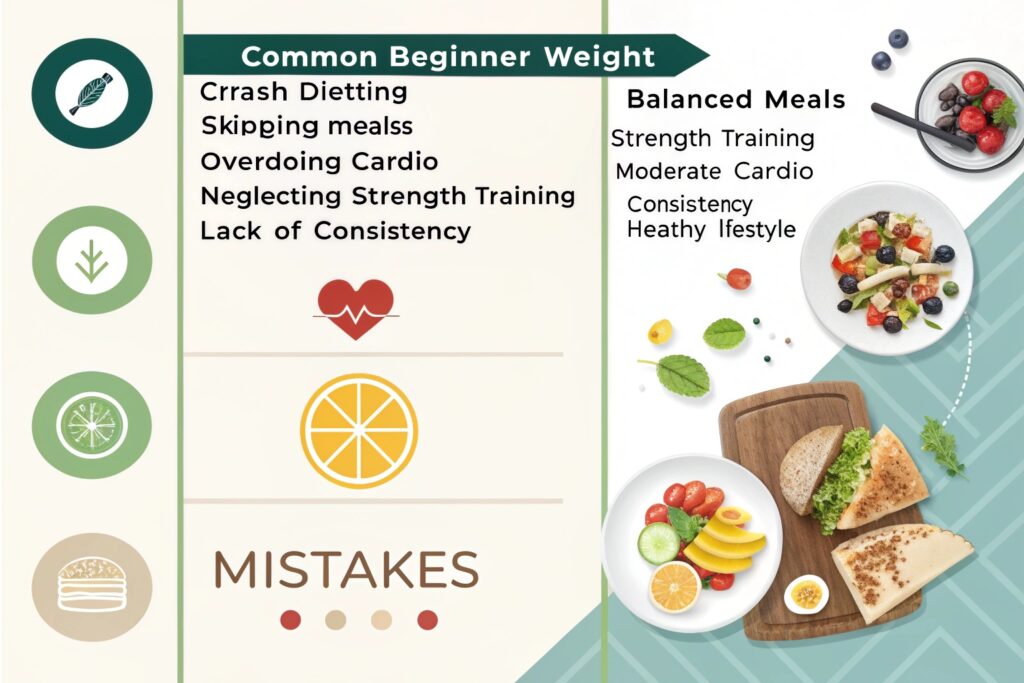Title: 5 Biggest Mistakes Weight Loss Beginners Make (And How to Avoid Them)
Introduction
If you’ve ever Googled “how to lose weight fast,” you’ve probably stumbled across countless diet plans, workout videos, and miracle‑pill promises. The truth is, most beginners trip over the same avoidable pitfalls. In this post we’ll dive deep into the 5 Biggest Mistakes Weight Loss Beginners Make (And How to Avoid Them), blending scientific research, real‑world case studies, and actionable strategies you can start using today. By understanding why these errors happen—and how to correct them—you’ll build a sustainable, evidence‑based foundation for fat loss, improved health, and lasting confidence.
Weight loss isn’t magic; it’s a complex dance of nutrition, metabolism, behavior, and mindset. Newcomers often focus on the “quick fix” without realizing that long‑term success depends on mastering the basics first. Below, we’ll unpack each mistake, illustrate the consequences with data, and give you concrete steps—backed by credentialed dietitians, exercise physiologists, and behavioral psychologists—to keep you on the right track.
1. Skipping Meals & Over‑Restricting Calories
Why It’s a Problem
Many beginners think “fewer meals = fewer calories,” so they skip breakfast or drastically cut portion sizes. Research from the American Journal of Clinical Nutrition (2022) shows that chronic under‑eating can lower resting metabolic rate (RMR) by up to 7 % within just two weeks, making it harder to lose fat despite a calorie deficit. Moreover, meals often triggers intense hunger spikes, leading to binge‑eating later in the day. The body’s hormone balance (ghrelin ↑, leptin ↓) becomes dysregulated, sabotaging appetite control and increasing cravings for high‑sugar foods.
How to Avoid It
-
- Calculate a realistic calorie target using a reputable TDEE (Total Daily Energy Expenditure) calculator and aim for a modest 10‑20 % deficit instead of a drastic cut.
-
- Eat 3‑5 balanced meals with protein, fiber, and healthy fats each time to keep blood glucose stable. A 250‑calorie protein‑rich snack (e.g., Greek yogurt with berries) can prevent energy crashes without blowing your budget.
-
- Track hunger levels on a 1‑10 scale; if you consistently feel “8‑10” before meals, you’re likely under‑fueling. Adjust by adding ~150 kcal of nutrient‑dense foods (nuts, avocado, whole grains) and monitor the impact on weight trend over two weeks.
2. Relying Solely on “Will‑Power” Without a Structured Plan

Why It’s a Problem- Weight‑loss enthusiasts love the idea of sheer determination, yet studies from the International Journal of Obesity (2021) reveal that people who set SMART goals (Specific, Measurable, Achievable, Relevant, Time‑bound) lose 2‑3 times more weight than those who rely on vague intentions like “eat healthier.” A lack of a concrete plan often leads to decision fatigue, where each food or workout choice feels overwhelming, increasing the likelihood of defaulting to familiar, less healthy habits.
How to Avoid It
-
- Create a weekly meal‑prep calendar: allocate 60‑90 minutes on Sundays to batch‑cook proteins, grains, and vegetables. Store them in portion‑controlled containers to eliminate daily guesswork.
-
- Schedule workouts like appointments: block 30‑45 minutes on your calendar for strength training, cardio, or mobility work, and treat them as non‑negotiable meetings.
-
- Use a habit‑stacking technique: pair a new habit (e.g., drinking a glass of water) with an existing routine (e.g., brushing teeth). This anchors behavior and reduces reliance on raw will‑power.
3. Ignoring Strength Training & Focusing Only on Cardio
Why It’s a Problem
Beginners often equate cardio with fat loss, but neglecting resistance training can be counterproductive. A meta‑analysis of 49 trials (ACSM, 2020) demonstrated that adding 2–3 weekly strength sessions accelerates fat loss by an additional 0.5 kg per month compared with cardio alone, largely because muscle tissue is metabolically active—burning ~6‑10 calories per pound at rest. Moreover, exclusive cardio can lead to loss of lean mass, reduced functional strength, and higher injury risk due to repetitive impact.
How to Avoid It
Incorporate compound lifts (squat, deadlift, bench press, row) 2‑3 times per week, even with light weights (40‑60 % of 1RM) to stimulate muscle protein synthesis.
Follow a periodized program: start with 3 sets of 12‑15 reps for hypertrophy, then progress to 4‑5 sets of 6‑8 reps for strength after 6–8 weeks. Tracking loads in a notebook or app helps you see progress and stay motivated.
Mix cardio modalities (HIIT, steady‑state, low‑impact) with strength sessions to protect joints while keeping calorie burn high. A 20‑minute HIIT interval (30 s sprint/90 s walk) after a strength workout can boost post‑exercise oxygen consumption (EPOC) by 15‑30 %.
4. Over‑Reliance on “Diet‑Specific” Foods and Fad Supplements
Why It’s a Problem
Keto chips, detox teas, and “fat‑burning” pills flood the market, promising rapid results with minimal effort. However, a review by the Food and Drug Administration (2023) concluded that >70 % of popular weight‑loss supplements have insufficient scientific backing, and some may cause side effects like jitteriness, insomnia, or hormonal disruption. Relying on “magic foods” also creates a false sense of security; people often ignore overall energy balance because they think a single product will compensate for poor diet choices.
How to Avoid It
-
- Prioritize whole foods: base meals on vegetables, lean proteins, whole grains, legumes, nuts, and seeds. These provide fiber, micronutrients, and satiety without hidden calories.
-
- Use supplements strategically: a daily 1,000 IU vitamin D, omega‑3 fish oil, or a magnesium capsule can support health, but they should never replace balanced meals.
-
- Check third‑party testing (NSF, Informed‑Sport) before purchasing any supplement to ensure purity and label accuracy.
5. Neglecting Mindset, Sleep, and Stress Management
Why It’s a Problem
Even with perfect nutrition and exercise, poor sleep and chronic stress can stall progress. The Harvard Medical School (2022) reports that individuals sleeping <6 hours/night have a 30 % higher risk of obesity, partly because sleep deprivation raises ghrelin (hunger hormone) and lowers leptin (satiety hormone). Stress triggers cortisol spikes, which promote visceral fat storage and cravings for high‑calorie comfort foods. Many beginners underestimate the power of mental resilience and recovery, focusing solely on the scale.
How to Avoid It
-
- Implement a sleep hygiene routine: dim lights 30 minutes before bed, keep the bedroom cool (≈65 °F), and aim for 7‑9 hours of uninterrupted sleep. Use a wearable tracker or sleep diary to identify patterns.
-
- Practice stress‑reduction techniques daily—5 minutes of diaphragmatic breathing, a 10‑minute guided meditation, or journaling about gratitude. Research shows that mindfulness can reduce emotional eating episodes by up to 40 %.
-
- Set realistic expectations: celebrate non‑scale victories (e.g., increased energy, better mood, clothes fitting looser). This reinforces intrinsic motivation, which is more sustainable than extrinsic “number‑focused” goals.
Practical Tools & Step‑By‑Step Guide to Implement Changes
Choose a Reliable Tracking System
-
- MyFitnessPal, Cronometer, or Lose It! all sync with fitness devices and provide macro breakdowns. Start by logging everything for 5‑7 days to establish a baseline.
Build a Weekly Meal‑Prep Blueprint
| Day | Breakfast | Lunch | Dinner | Snack |
|---|---|---|---|---|
| Mon | Oatmeal + whey + berries | Grilled chicken salad | Baked salmon + quinoa + broccoli | Apple + almond butter |
| Tue | Veggie omelet | Turkey wrap (whole‑grain) | Stir‑fry tofu + brown rice | Greek yogurt |
Adjust portion sizes to match your calculated calorie target, aiming for 25‑30 % protein, 30‑35 % fat, and 35‑45 % carbs.
Strength‑Training Template (Beginner)
| Day | Exercise | Sets | Reps | Rest |
|---|---|---|---|---|
| Mon | Goblet squat | 3 | 12 | 60 s |
| Mon | Push‑ups (knees if needed) | 3 | 10‑12 | 60 s |
| Wed | Dumbbell deadlift | 3 | 12 | 60 s |
| Wed | Bent‑over row | 3 | 12 | 60 s |
| Fri | Lunges | 3 | 10 each leg | 60 s |
| Fri | Plank | 3 | 30 s | 45 s |
Progressively increase weight or reps every two weeks.
Stress & Sleep Checklist
-
- Morning: 5‑minute breathing exercise after waking.
-
- Afternoon: 10‑minute walk outside (natural light boost).
-
- Evening: Turn off screens 1 hour before bedtime; read a physical book or practice gentle yoga.
Weekly Review & Adjust
Every Sunday, review weight trends, energy levels, and compliance. If weight loss stalls >0.5 kg for 2 weeks, consider adjusting calories by –100 kcal or adding another 10‑minute HIIT session.
Frequently Asked Questions
Q1: How fast should I expect to lose weight safely?
A: A sustainable rate is 0.5‑1 kg (1‑2 lb) per week, aligning with CDC guidelines. Rapid loss often results from water weight or muscle catabolism and is hard to maintain.
Q2: Can I eat carbs and still lose fat?
A: Absolutely. Carbohydrates are not the enemy; they provide energy for workouts and brain function. Focus on complex carbs (whole grains, legumes) and match portions to your total calorie goal.
Q3: Do I need to count calories forever?
A: Not necessarily. Once you internalize portion sizes, hunger cues, and activity levels, you can transition to intuitive eating. However, periodic check‑ins (once a month) help keep you accountable.
Q4: What if I have a medical condition (e.g., hypothyroidism)?
A: Consult a healthcare professional before starting any weight‑loss program. Many conditions affect metabolism, and a personalized plan may be required.
Conclusion & Call‑to‑Action
Understanding and sidestepping the 5 Biggest Mistakes Weight Loss Beginners Make (And How to Avoid Them) is the cornerstone of a thriving, healthy transformation. By adopting a balanced calorie approach, crafting a structured plan, embracing strength training, staying skeptical of fad supplements, and nurturing sleep, stress, and mindset, you set yourself up for lasting success—not just a fleeting number on the scale.
Ready to put these strategies into action? Download our free 7‑day starter checklist (link below) and share your progress in the comments. Your story could inspire others, and together we’ll build a supportive community that thrives on evidence‑based growth.
If you found this guide helpful, please share on social media, subscribe for weekly expert tips, and check out our related articles on “Meal‑Prep for Busy Professionals” and “HIIT vs. Steady‑State Cardio: Which Burns More Fat?”



